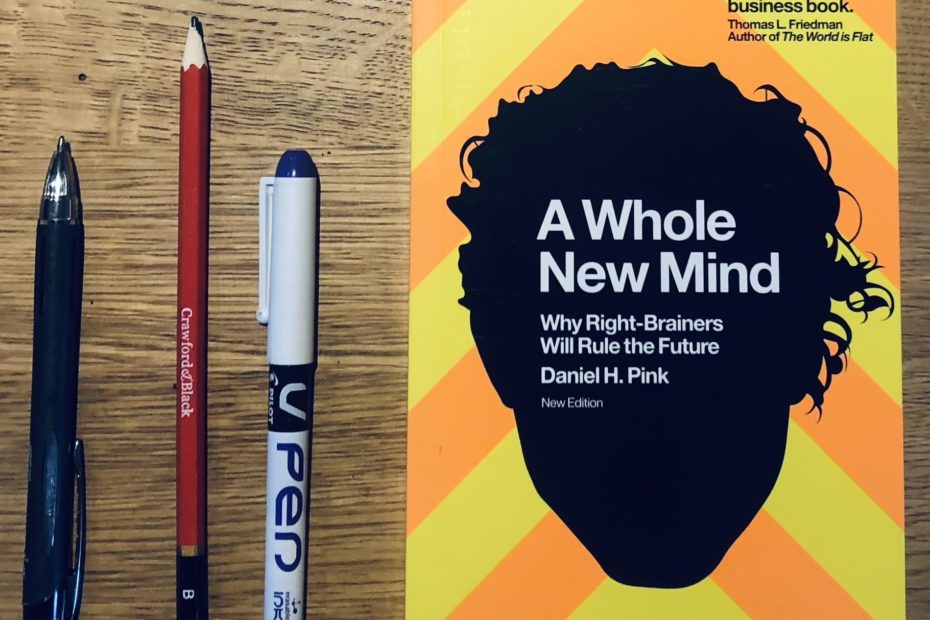I recently compiled a list of the best books on innovation and creativity and among them is Daniel Pink’s A Whole New Mind: Why Right-Brainers Will Rule the Future. It was first published in 2005 and has gone through various updated editions. Sixteen years on, I wondered if Pink had been right: are right brainers ruling in 2021? The irony of his book is that it sets out such a compelling case for being right-brained that it will surely appeal to the logic of any left-brainer who reads it.
Pink argued that so-called ‘left-brain’ traits had fuelled the Information Age, but that we were moving into a Conceptual Age where ‘right-brain’ traits will prevail. Such traits include inventiveness, empathy, joyfulness and meaning, all of which are essential for professional success and personal fulfilment – perhaps never more so than now, as we grapple with the economic and social consequences of a global pandemic.
There were three key drivers for this shift towards the need for right-brained thinkers according to Pink. Firstly, the abundance of our material lives in the 21st century means that people have started looking for beauty and meaning. Secondly, the outsourcing of knowledge working (such as computer programmers, lawyers and physicians) to Asia means there is less value in traditional professions. And finally, automation and machine learning have begun to render ‘learnt’ skills redundant.
So what exactly do the left and right sides of the brain do differently? The left hemisphere of the brain is the seat of rational, analytical and logical thought. It is responsible for language and convergent thinking. It helps us see and understand the details. The right hemisphere of the brain on the other hand is nonlinear and instinctive. It excels at pattern recognition, holistic reasoning, interpreting emotions and non-verbal expressions. It is responsible for divergent thinking and helps us see the bigger picture.
In reality, both hemispheres of our brains are engaged in almost everything we do. But Pink uses the idea of the left and right as a metaphor for how individuals and organisations see the world. L-Directed thinking is the result of left-brain attributes and has long been emphasised and measured in schools, even though only 4-10 per cent of career success is attributable to IQ measures. R-Directed thinking is characterised by simultaneous, metaphorical, aesthetic, contextual attributes.
There are six essential abilities, according to Pink, that we would need to cultivate in the Conceptual Age:
- Design – in our age of abundance, products can’t just be functional, they must be well designed: good user design is needed to differentiate products. Great design is utility enhanced by significance.
- Story – the amount of data and content we can access produces a need for a compelling narrative. Most of our experience, knowledge and thinking is organised as stories, which can explain the past and cast predictions for the future. It is about putting facts in context and imbuing them with emotion. And story is becoming a key means of businesses distinguishing their products in a crowded marketplace.
- Symphony – the increasing specialism of the Industrial Age has left a skills gap of people who can see the bigger picture. By making connections between domains, by synthesizing rather than analysing, by recognising patterns and making bold leaps of imagination, new ideas can be born.
- Empathy – forging relationships and understanding what makes others tick will matter more than logic in our age of advanced analytics. It’s also a vital leadership skill. Hard for machines to reproduce, and very much the preserve of the right brain, the ability to see from the perspective of others is also vital for good user design.
- Play – the personal well-being and professional benefits of a space to play is becoming ever more necessary in our fast-paced and career-focused lifestyles. Pink argues that playing video games can help sharpen our problem-solving skills and that the right-hemisphere of the brain is vital for understanding and appreciating humour. Joyful laughter can lead to greater productivity, collaboration and creativity.
- Meaning – material gain isn’t reason enough for our work today, we need to find purpose in what we do. The Dalai Lama says we are all seeking something better in life, and people who have learned to meditate find their brains are more able to make new insights, concentrate better and increase cognitive capacity. People whose spiritual values align with organizations values are more likely to outperform their colleagues.
A Whole New Mind is full of practical ideas to improve our performance in each of these six areas. It is also draws on the work of a wide range of neuroscientists and cognitive psychologists to offer some brilliant ideas for nurturing your creative brain. To my mind, strange mix of left and right that it is, Pink’s thinking has proven prophetic. Never has it been more important to mindfully practise creativity.
Click A Whole New Mind: Why Right-Brainers Will Rule the Future by Daniel H. Pink (Marshall Cavendish, 2008 edn) to buy a copy of the book, while also supporting independent bookshops.
